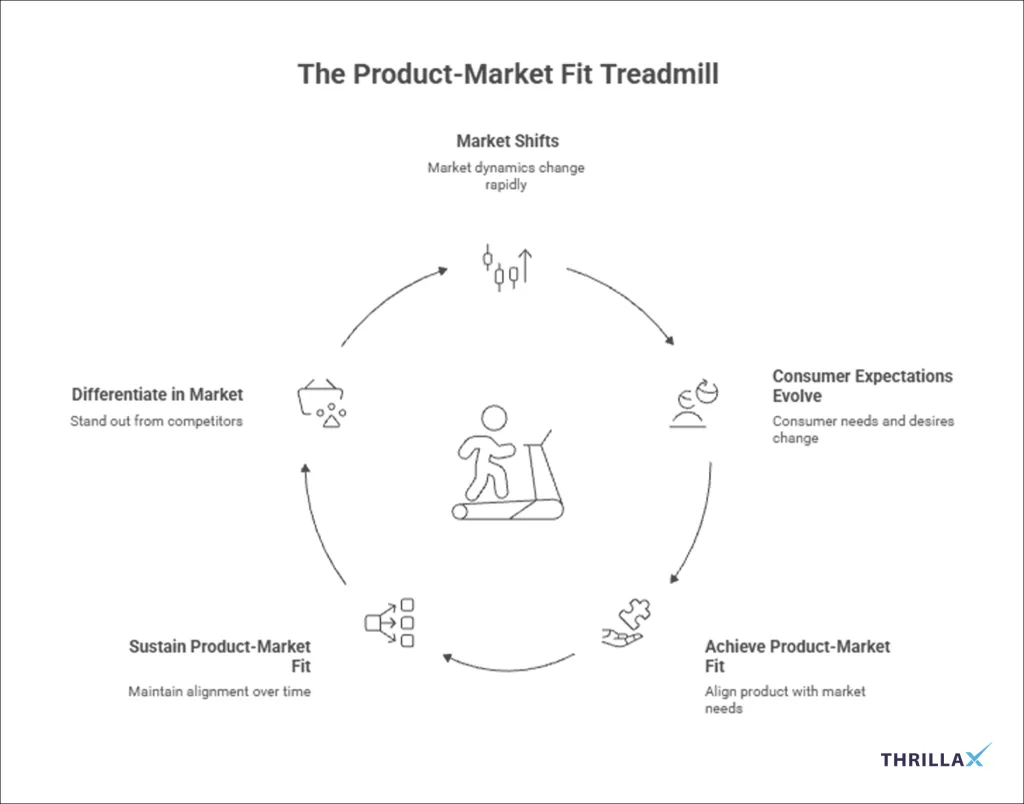The Product-Market Fit Treadmill: Why Every AI Company Is Sprinting Just to Stay in Place


In a world where technology, competition, and user expectations evolve rapidly, what works today might be obsolete tomorrow.
Understanding this “PMF treadmill” is essential for any founder or business leader aiming for long-term relevance and growth.
What Founders Usually Get Wrong About Product-Market Fit
There are common misconceptions around PMF:
- Thinking PMF is permanent, but in AI, change is constant.
- Believing that early traction equals long-term fit, initial user signups don’t guarantee retention.
- Assuming a one-size-fits-all product works across niches, context and domain specificity often matter more.
Reality for AI (and SaaS) businesses is that PMF needs constant re-validation: every update, every pivot, every new feature changes the product-market equation.
A Reddit founder captured this bluntly:
“I started my AI tool, launched after 6 weeks, but no one used it, even for free. We didn’t research demand. That failure taught me to validate before coding.”
That’s a classic trap

It’s the same pattern we see in marketing, too; most SEO projects don’t need more tactics, they need clarity, direction, and alignment with real demand.
Why Every AI Company Is Forced to Sprint
1. Technology Evolves Faster Than Product Lifecycles
Between cloud infrastructure upgrades, AI model releases, and shifting data requirements, what’s a competitive advantage today may be baseline tomorrow.
Per a recent analysis of AI-era SaaS failures, over-engineering for breadth rather than solving a core problem remains a top reason many tools don’t survive.
Tip: Design around a core use-case. Modular architecture + clear problem focus reduces the “rewrite-from-scratch” risk.
2. Customers Expect Results Quickly, And That Expectation Rises
Buyers of AI products now demand fast time-to-value, clear ROI, and seamless integration. Delay or friction kills adoption.
In one thread discussing AI-startup failures, a founder said:
“Most AI businesses fail simply because they aimed for big, flashy features but never delivered real value fast enough.”
How I Helped Startups Avoid Failing at AI
by u/praveen_vr in
StartupsHelpStartups
Delays, unclear value, or overpromised features can kill the perceived fit, even if the tech is solid.
Tip: Establish bi-weekly customer feedback loops and track feature adoption to stay aligned with needs.
3. Competition and Copycats Are Everywhere
When tech is easy to replicate, e.g. building on top of common LLM or models, the hard differentiator becomes user insight, execution speed, and domain depth.
Many founders on Reddit have echoed this, launching multiple iterations before finding success:
“First two startups failed, tech wasn’t the issue. We were trying to build everything. Once we picked one niche and stayed extremely focused, we saw traction.”
2 failed startups. 1 mild success. Everything I wish someone told me earlier.
by u/Ok_Negotiation_577 in
SaaS
Generic tools often die because they don’t solve a specific problem deeply.
Tip: Focus on niche differentiation, brand trust, and proprietary IP to survive competition.
4. Regulation & Ethics Aren’t Optional, They are Accelerators
With evolving global AI regulation, privacy concerns, and compliance requirements, AI products need governance baked in. Ignoring these can cost you users, market access or even legal standing.
Tip: Integrate compliance and ethics checks into every development iteration, not as an afterthought but as part of your core roadmap.
The PMF Treadmill Framework
Use this as a mental model to understand how PMF works in a world that never stands still:

Market Shifts > Consumer Expectations Evolve > Product-Market Fit (temporary) > Must Sustain PMF or Lose Fit > Repeat.
- Market Shifts: Market dynamics change rapidly, with new tools, competitors, and regulations.
- Differentiate in Market: To survive, you need more than features; you need unique value.
- Consumer Expectations Evolve: As users grow accustomed to better AI, their needs and desires change faster.
- Sustain Product-Market Fit: Companies must continuously adapt their offerings to stay relevant.
- Achieve Product-Market Fit: At any point in time, align product capabilities with market needs.
Treat PMF not as a milestone, but as a cycling process of alignment, adaptation, and differentiation.
How to Sprint Smarter: Our PMF Survival Framework

Here’s a repeatable model we recommend for AI founders and teams. Think of it as a routine, not a project.
Measure what matters
- Track retention, feature adoption, user engagement, time-to-value.
- Lean into qualitative feedback, user interviews, surveys, support logs, not just metrics.
Iterate in micro-cycles
- Weekly or bi-weekly micro-improvements vs. infrequent big releases.
- Rapid UX feedback loops, A/B tests, beta releases.
Go vertical / niche-first
- Target a clearly defined problem or industry vertical.
- Build high relevance before scaling horizontally.
Automate insight collection
- Use analytics dashboards, user-behaviour trackers, and AI tools to detect usage patterns.
- Let data guide your product roadmap.
Keep feedback loops constant.
- Monthly user interviews or surveys.
- Use findings to drive feature prioritisation.
Communicate honestly with users.
- Transparency about limitations and roadmap expectations buiuser-behaviour reduces churn risks.
Ready to Sprint Smarter? Tell Us About Your Business
Understanding product-market fit is just the first step. Thrillax helps companies design growth strategies, implement feedback loops, and execute faster.
If you are serious about accelerating your AI or digital business, start by filling out our quick form

Why Fill This Form:
- We are picky because good work requires the right fit.
- We need to understand what you are building, why it matters, and what you expect from us.
- Your answers help us recommend the right strategy and support level.
Completing the form ensures we tailor solutions to your needs, no cookie-cutter strategies, just growth that makes sense.
FAQs
In AI, PMF is rarely permanent because models, competitors, and user expectations evolve constantly. What feels like a perfect fit today can become outdated in weeks if you stop innovating.
The companies that maintain long-term PMF treat it as an ongoing process, not a milestone.
If users sign up but don’t return, rely on support to understand basic features, or only use 1–2 parts of the product, PMF is weak. Early traction or hype doesn’t count unless users keep coming back consistently.
A product that needs constant pushing hasn’t achieved real PMF.
PMF holds only if you continuously track usage, adoption, churn triggers, and feature depth. AI teams need monthly value audits, quarterly competitor scans, and modular architecture.
The goal is to adapt faster than the market shifts, not chase every new model release.
Time-to-first-value, 30/60/90-day retention, feature adoption, solve rate, and active usage depth matter more than signups. These reveal whether users see repeated value.
If retention or solve rate drops, PMF is slipping even if new users keep coming in.
AI products often suffer from a short-lived “wow” phase. Once the novelty fades, users expect accuracy, speed, and seamless integration. Errors break trust fast.
If the AI doesn’t improve its workflow consistently, users will switch quickly to similar tools.
Focus on one painful use case and one power user segment. Don’t build a platform—build the best solution for one workflow.
A narrow wedge wins faster because the value becomes undeniable. Expansion comes only after one use case becomes irreplaceable.
Differentiation comes from outcomes, not hype. Proprietary data, niche specialisation, better solve rate, and simpler UX matter more than fancy features.
The winning product is the one users trust to deliver consistent, reliable results—not just generate output.
Scale only when retention stabilises, solve rate is high, user complaints decrease, and one acquisition channel works reliably.
Growing before PMF means burning money without progress. Scaling is a reward for consistency, not early traction.


